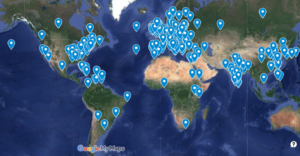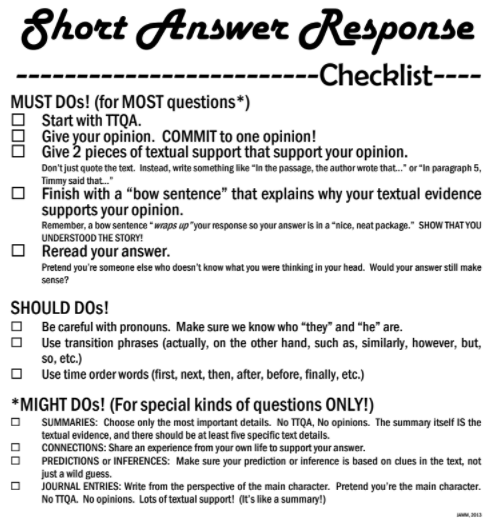Posts By: Jon Moss
April 23, 2019
Blending Geography with Literacy and Technology
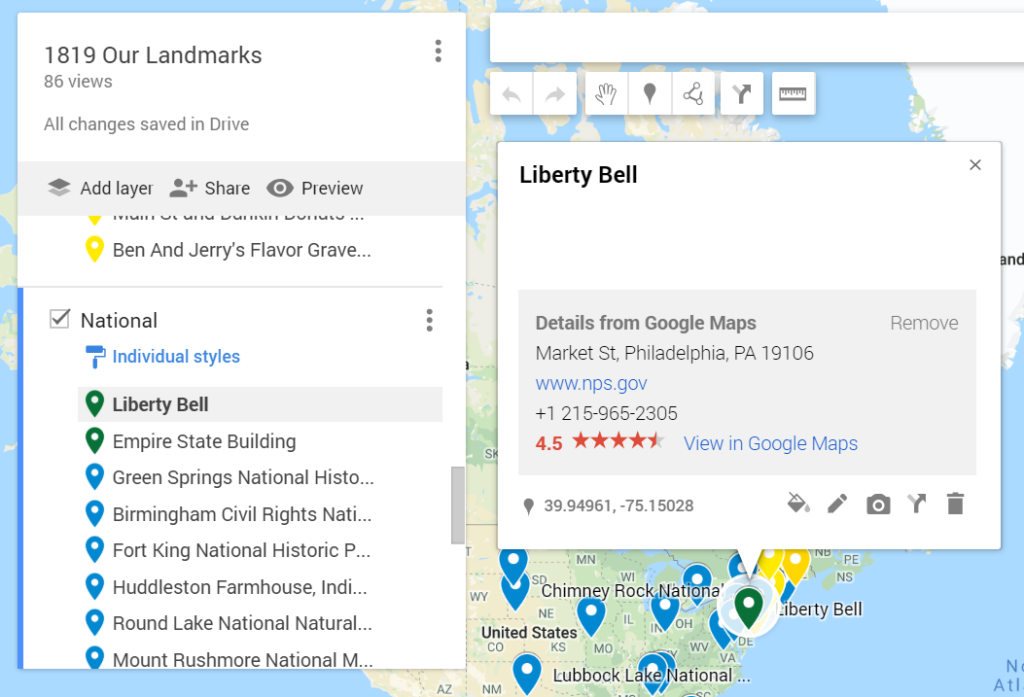
We first made this MyMap, in which students brainstormed different landmarks and classified them as local, regional, national, or international landmarks.
In our class, we’ve been blending one of our social studies focus areas (map skills) with our various reading units. Many of you are familiar with Google Maps, which many of us use for GPS navigation or to plan routes. But you may not be familiar with Google MyMaps. MyMaps is a tool available to educators that lets students and teachers build their own custom maps. In these custom maps, users can pin locations, link to photos and information available online, write their own custom content, measure distances, show routes, and much more. In the fall, we first used MyMaps to learn about the difference between local, regional, national, and international landmarks. Students brainstormed different landmarks and classified them based on how well-known they were. This also helped students to become familiar with the idea of MyMaps.
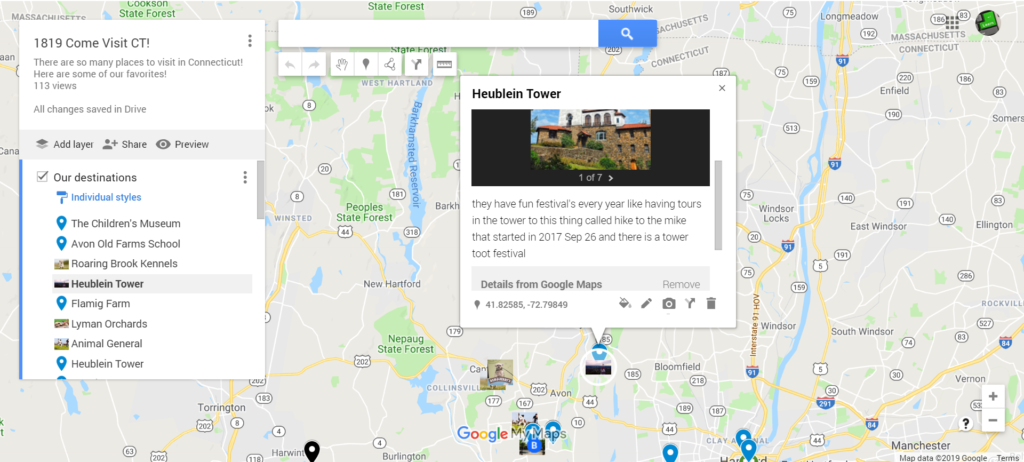
Students shared information about their Connecticut landmarks, including both photos and text, in order to create a virtual tour of the state.
Shortly after, we used MyMaps to create a virtual showcase for the students’ Connecticut Landmark Advertisement Projects. We scanned in the students’ advertisements, and they found the locations on the map, wrote a few sentences to introduce us to their landmark, and embedded photos of their advertisement as well as other found photographs of that landmark. For privacy reasons, an interactive version of this map is not available here. (It has student names included.) But students can always share this with their families from their Google Classroom page.
In January, in preparation for our annual multicultural fair, students in our class mapped out communities from which members of our PGS community originally came. Sometimes we knew specific cities, and in other situations, we knew only the country. While this may sound like a massive undertaking, we quickly built this map, thanks to the students’ proficiency with MyMaps. At the multicultural fair itself, students and families got to enjoy an animated tour of each of the 604 locations as we used Google Earth to zoom in and out of each community.

Also in January, our class started a study of the outstanding novel Number the Stars. As we read the book, which teaches students about life in Denmark during the German occupation in 1936, we found that many real-world landmarks were included in the book (which is considered to be realistic, historical fiction). As we read, we plotted the locations on a MyMap and have been able to better understand the text by learning about many of the places. For example, in the book, the narrator and character Annemarie tells the reader that they can see across the water to Sweden. By measuring, we discovered that it is about 10 miles from the shoreline town of Gilleleje to the closest part of Sweden. Students found their own homes and measured to locations that were a comparable distance away. (They discovered, for example, that seeing the Hartford skyline while driving over Avon Mountain is probably similar to the sight of Sweden from the harbor town of Gilleleje.) Other students learned about Amalienborg, the beautiful palace home to the former King Christian X of Denmark, who is included in the novel. A 360-degree tour of the palace courtyard gave students a glimpse into this far away land. Students are now pulling together the information they’ve learned and are going to embed these facts into our MyMap, which will create a virtual tour of the country of Denmark, as it relates to Number the Stars.
I’m excited to share that we’ve been accepted to share our work with MyMaps at the State Capitol next week! Four students will have the opportunity to join me to showcase our work with this creative resource! If you have any questions about this event, or about our use of MyMaps in general, please feel free to contact me.
Posted in Class Updates|By Jon Moss
January 27, 2019
Learning about Civil Rights
 Martin Luther King Day is such an important day in our country, and in our class, it kicked off our informal unit about Civil Rights. On The Thursday before Martin Luther King Day, we read the first half of a wonderful book called As Good As Anybody. This book tells the story of Martin Luther King Jr., starting from his life as a young boy. It gave us a wonderful opportunity to talk about the concepts of discrimination, segregation, separate-but-equal (and the inherent flaw in that idea) and more. I’m always glad to see how confused kids are by this – The idea of treating someone unkindly because of their skin color was totally alien to the kids, and they couldn’t fathom how someone would do this to another person. To better illustrate this, we discuss the idea of gender-based discrimination: Are boys better at math than girls? A lot of people think so, so what happens when a male and female are applying for a job at an architectural firm? We discussed how some people might make an unfair decision, and we extended this to form a concept about racial discrimination. Helping kids to build a frame of reference better enables them to understand these ideas. This launched us into our continuing study of diversity and civil rights.
Martin Luther King Day is such an important day in our country, and in our class, it kicked off our informal unit about Civil Rights. On The Thursday before Martin Luther King Day, we read the first half of a wonderful book called As Good As Anybody. This book tells the story of Martin Luther King Jr., starting from his life as a young boy. It gave us a wonderful opportunity to talk about the concepts of discrimination, segregation, separate-but-equal (and the inherent flaw in that idea) and more. I’m always glad to see how confused kids are by this – The idea of treating someone unkindly because of their skin color was totally alien to the kids, and they couldn’t fathom how someone would do this to another person. To better illustrate this, we discuss the idea of gender-based discrimination: Are boys better at math than girls? A lot of people think so, so what happens when a male and female are applying for a job at an architectural firm? We discussed how some people might make an unfair decision, and we extended this to form a concept about racial discrimination. Helping kids to build a frame of reference better enables them to understand these ideas. This launched us into our continuing study of diversity and civil rights.

Leaders of the protest, holding flags, from left Bishop James Shannon, Rabbi Abraham Heschel, Dr. Martin Luther King and Rabbi Maurice Eisendrath.” Tomb of the Unknown Soldier, Arlington Cemetery, February 6, 1968. Published February 7, 1968. (Photo by Charles Del Vecchio/Washington Post/Getty Images)
On Friday, we finished reading As Good As Anybody. The second half of the book taught us about Abraham Joshua Heschel, a Jewish man who fought for the rights of Jews who were being persecuted, much as Dr. King did for African Americans. The two men teamed up and worked together to accomplish their shared goal of earning equal civil rights and fair treatment for ALL.
While the kids were, of course, familiar with Dr. King, Abraham Joshua Heschel was a new name to them. The book hints at how Jews were treated unjustly in Europe during World War II, and it lets us add to our previous understanding of discrimination by race or gender by understanding the idea of discrimination by religion. This transitions beautifully to an activity we’re starting on Monday.
On Monday, fourth graders at PGS will start a unit of study about a wonderful novel. Throughout the week, theater educators from the Hartford Stage will join our class to teach the kids about the novel Number the Stars, which tells the story of a fictional family in Denmark that helps to hide a Jewish family that tries to escape from the Nazis during the Holocaust. Following the Hartford Stage residency, we will begin reading this novel as a class.
Posted in Class Updates|By Jon Moss
December 11, 2018
Redesigning Our Class Library
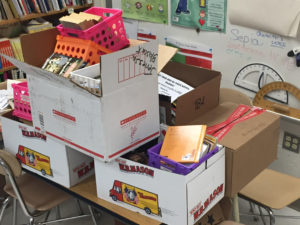
When you visited our room for your fourth grader’s parent-teacher conference, you may have seen a table that was filled with boxes upon boxes, all filled with books. No, this isn’t our new freestyle shelving system. Rather, it’s a work in progress as we tackle a months-long project to reorganize our class library.
The project began at the start of the school year. This year, our school’s goal is to harness the power of independent reading by (a) ensuring that structured independent reading time allows students to focus on specific skills, and (b) helping students to read books that are at an appropriate reading level for them. (At our conference, you should have received a packet with information about your fourth grader’s reading level. If you haven’t yet gotten one, it will be coming home tomorrow. Please ask your kids for them, as they’re now in their mailboxes waiting to go home.) In order to help students to find texts at their level, we’ve tackled a complete revision of our class library.
This started a few months ago with the forming of our class library committee. It was open to any and all students who wanted to participate. We ended up with 11 students, which has been terrific! Our first task was to weed through our existing library and remove books that were either in poor condition or were unlikely to grab the interest of prospective readers. I knew we needed plenty of room to add more books, so we were pretty ruthless in removing old books. (I hate to throw away books, so many were given to students.) Next, the kids went shopping, both in the Scholastic Book Club catalogs and at our school’s book fair. They had the shopping cart, and Mr. Moss had the credit card! Soon, we had a few hundred books to add to our library (and Mr. Moss’s splurge budget for the next few months shrunk! HA! :-D)
Our next step was to catalog and level our books. That serves two purposes. First, we’ll be left with a searchable spreadsheet that will allow students to look for books by particular authors, books at a particular level, or books with a particular title. Our library won’t be organized by these factors, necessarily, so having a resource within which they can search will be valuable! Also. students are working to level the books. All books have a level, which measures the text complexity. That’s more than just how hard the WORDS are, and also includes style of writing, character situations, chronology, prior knowledge required, etc. We’re looking up the reading levels based on what we find on Scholastic’s site, using an app, etc. That information is getting added to the catalog spreadsheet.
Our next step, once all the books are cataloged and leveled will be to print out labels, both for the inside covers of the book and for sign-out cards that we’ll use to keep track of who has which book checked out. Once that system is in place, you can expect students to start to bring home books at their level. Stay tuned!
More cool news is that we’ll be receiving a leveled book cart from the district in the coming months. What’s cool about this is that it will be organized differently from our library. While our class library will be organized by theme, series, author, topic, genre, and other factors (with books of a variety of levels within each section), the book cart will be organized by level, with books of different topics within each level. So when students want to search by topic, they can begin in our library. When they want to search by level, they can begin with the cart.
This wouldn’t be possible without the incredibly hard work of our class library committee volunteers. They’ve worked tirelessly to help us reach this point. Now we’re in need of more help (from adults). I’m looking for some volunteers to help us with the leveling of books. Some parts can be done in school, with the committee members. But for all of you who are unable to come during the day but still want to help, here’s an opportunity for you to help us from the comfort of your own home! If you’d like to volunteer, please email me and tell me whether you’re looking for a daytime slot (M, T, or W between 1:30-2:00 – later on, other slots will open up as well) or if you’d like an at-home job, which can be done at your convenience. As usual, I’ll follow-up with you to let you know what’s available, since we may have more volunteers than needed. (What a GREAT problem to have!) Thank you for considering!
Posted in Class Updates|By Jon Moss
November 14, 2018
How Written Responses Are Evaluated
With report cards going live this morning and parent conferences kicking off tomorrow afternoon, I wanted to take a moment to encourage you to visit your child’s Google Classroom page. You’ll need to login with his or her username and password, but the students know that she should always be willing to share their login information with their parents/guardians. On our Google Classroom page, you’ll find much of your child’s written work, including responses to text (check out “A Chair for My Mother SAR”) and descriptive writing (look for the “Summer Snapshot” writing) projects. Feel free to look around, but PLEASE allow your child to do his or her work at school, and please resist the strong urge (Hey, I get it!) to help your child to improve the works-in-progress you see (since I won’t know what’s your child’s work and what is your work).
While not all the documents you’ll come across are intended to be graded (as some are planning tools for other purposes, others are collaborative practice, etc.), those tasks that are assessed are graded within the document itself. All grades and comments from me are written in yellow text, highlighted in black. Bold as that is, it clearly distinguishes my work from your child’s work. (Think of that color pattern as my trademark “teacher’s red pen”, if you will.)
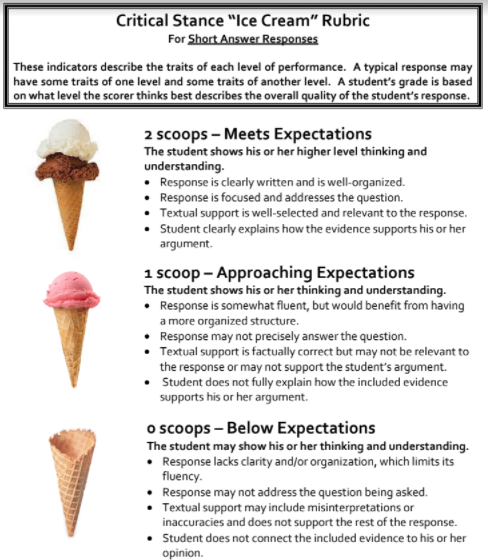 Short answer responses are most typically assessed on a 0-1-2 point scale. Here is a copy of the rubric we use. I want to stress that 0, 1, and 2 should not be converted into a percentage. That is, I’d hate for you to think a score of 1/2 is the same as 50% (a failing grade) or that 2/2 is 100% (perfection). Rather, a 2/2 is a proficient response that includes all the elements I am looking to see. Could it potentially be improved? Of course! A 2/2 doesn’t mean that it’s perfect, just that it met expectations. Likewise, a 1/2 isn’t a failing grade. It means that the student is well on his or her way to developing a successful response, but he or she needs to improve one or more parts of the response in order to reach a 2. When I give a 1, I find myself most often asking students to give more textual support, to select more appropriate textual support, or to focus their response on a single idea and develop that idea more thoroughly. You’ll always see comments from me to explain why your child received the score he or she did.
Short answer responses are most typically assessed on a 0-1-2 point scale. Here is a copy of the rubric we use. I want to stress that 0, 1, and 2 should not be converted into a percentage. That is, I’d hate for you to think a score of 1/2 is the same as 50% (a failing grade) or that 2/2 is 100% (perfection). Rather, a 2/2 is a proficient response that includes all the elements I am looking to see. Could it potentially be improved? Of course! A 2/2 doesn’t mean that it’s perfect, just that it met expectations. Likewise, a 1/2 isn’t a failing grade. It means that the student is well on his or her way to developing a successful response, but he or she needs to improve one or more parts of the response in order to reach a 2. When I give a 1, I find myself most often asking students to give more textual support, to select more appropriate textual support, or to focus their response on a single idea and develop that idea more thoroughly. You’ll always see comments from me to explain why your child received the score he or she did.
How does your child know what goes into a 2/2 response? Good question! In our class, we use a short answer response (SAR) checklist to help students know what a thorough response looks like. Pictured to the right, this checklist lets students organize their writing. Your child should be able to explain to you what things like TTQA and “bow sentences” are.
Other areas, such as organization, sentence structure, grammar, capitalization and punctuation, and spelling are assessed using our report card scale: EMAB. A score of M is most common, indicating that a student is meeting grade-level expectations. An E means that a student has exceeded my grade level expectations. It’s important for you to understand that I don’t look at an M as falling short of earning an E, even though many families tend to feel this way. When a student’s work goes above and beyond and shows a particularly sophisticated application of the concept or skill, he or she may earn an E. Parents often ask “What does my child need to do to earn an E?” That’s really hard to answer. Allow me to provide an example. Imagine a student wrote the following description of our classroom:
There are homemade posters, called anchor charts, hanging all over from lessons. They help us to remember what Mr. Moss taught us. There are also book boxes that alternate in color between yellow and green. These hold all the great books that we get from our class library, school library, or from home. The colorful paper lanterns add even more color to our classroom.
That was a perfectly good description of our classroom, and if I was assessing the response’s sentence structure, it would earn an M. Now compare it to this response:
In our classroom, homemade posters hang all over. Called anchor charts, these tools help us to remember what Mr. Moss has taught us. The yellow and green book boxes add a splash of color to the room, as do the hanging colorful paper lanterns.
It’s clear that this second passage is a more sophisticated style of writing, and it’s sentence structure grade would be an E. But if a parent were to ask me what their student (writer of the first response) needs to do to improve, I’d have a hard time explaining it. The growth comes naturally, as a student becomes a more mature writer. As their overall use of the written English language matures, so will these discrete sentences. It’s the same with word choice. I’d hate for a parent of a student earning an M for word choice to have their child study new vocabulary words with the specific goal of earning a better grade. Instead, as the child reads more mature books with more mature word choices, it’s reasonable to expect that their lexicon will continue to grow and develop.
A grade of A means that a child is approaching the goal, is continuing to work to develop his or her skills in a given area, and has more work to do before reaching goal. An A isn’t a disaster. While I do want to avoid seeing too many A’s in a student’s work, it can serve as a focus area for your child (and perhaps for you, as you work to support your child). Finally a B means that your child’s work is below expectations and that he or she has plenty of room to grow.
I look forward to answering any of your questions about this when we meet for parent-teacher conferences. But in anticipation of our upcoming conversation, please take a moment to look at your child’s Google Classroom page so you are best informed of his or her progress in class.
Posted in Class Updates|By Jon Moss
November 4, 2018
Methodical Math Mania!
In room 209, we have been working hard on a variety of different math skills. In our current unit, which we’ll be assessing this week, students have learned about factors, multiples, the order of operations, patterns, problem solving, and more. I hope that the videos I’ve posted are helpful to you, both in keeping you up to date on what skills we’re covering and in better equipping you to support your fourth grader. Students have been working very hard in math.
Our first math unit focused on place value, addition, and subtraction. You may be wondering about the unit 1 assessment scores. When I review student assessment results, I look to see what strengths emerged and which areas were challenging for students. When I see that a few students have struggled with a particular area, I pull groups to review the difficult skills. When the number of students struggling with a skill is larger, it shows me that I need to do some reteaching for the whole class. On the unit 1 assessment, I saw that the majority of students continued to need practice with rounding and with a few other place value skills. Over the past few weeks, I’ve been reviewing various skills with small and large groups of students, and we’re going to continue this work to ensure that students have a solid foundation for our upcoming units. So while these assessments haven’t gone home yet, I look forward to reviewing them with you in person at our upcoming parent conference so we can discuss your fourth grader’s progress.
We’re also working on improving students’ addition and subtraction facts. Students are making progress in these skills, but this may also be a good focus for home practice. This may come as a surprise for you, as the big focus in third grade was multiplication. Fear not, we’ll soon return to multiplication facts as we dive into the multiplication units of study. But I often find that students’ addition and subtraction fact mastery tends to slip when they shift their focus to multiplication. So by taking the first marking period to work on addition and subtraction facts, I’m again hoping that students will have a solid basis for the skills in the upcoming units of study.
Posted in Class Updates|By Jon Moss
September 28, 2018

Why Read 2018
Our class did a TERRIFIC job performing at today’s Town Meeting!
Posted in Class Updates|By Jon Moss
September 24, 2018
Starting Homework
Hello, families! Today, we’re kicking off our homework routines. They’re quite a bit different from past years, but I strongly believe we’re improving the learning process for kids in making these changes. Each week, students will receive a single math assignment. It is intended to be completed over multiple nights and will cover a variety of topics that we’ve taught in prior weeks. The idea is that the concepts on the homework aren’t BRAND new and, instead, are ones with which students have had a good amount of practice. (We all know how frustrating it is for students – and families – when they bring home a worksheet based on the day’s challenging lesson, and come home thoroughly baffled! That doesn’t help anyone! By basing the week’s homework on past weeks’ skills, ones they’ve practiced and applied, I’m hopeful that students will feel more confident and proficient.) When there’s something on the homework that I expect will be unfamiliar to parents, I will do my best to send out a video to help families understand the strategy we’re using in class. Tonight, for example, you’ll see two items that involve renaming numbers. (2,900 = __ hundreds, for example.) Here is a pair of videos to bring you up to speed on the strategy I’ve taught students.
Homework for reading and writing will take more of a varied form. Sometimes, it will be an activity directly tied to a skill we’re working on in class. For example, this week, students will be asked to keep track of the thoughts they have as they read. (We’ve been working on this a lot in class.) Other times, students will be given an assignment tied to the book they’re reading at home. Or their homework may set the groundwork for an upcoming lesson.
Remember, students always have free-choice reading for homework (around 30 minutes), and they should always take time to practice those often-elusive math facts. Stay tuned for ideas on both of these responsibilities.
If you ever have any questions about homework or anything else, please feel free to contact me!
Posted in Class Updates|By Jon Moss
September 6, 2018
2018-2019 Curriculum Night
Hello, families! Thank you for joining me for my very long (sorry) presentation this evening! I hope you found it helpful! If you weren’t able to join us in the classroom, you can join us from the comfort of your own home! Here’s a recording of the session for you to enjoy:
At the end of the session, my computer decided that I’d gone on long enough and that it was time for me to wrap it up. But the only thing we missed was a slide telling you to visit our class website (which you’ve done, if you’re reading this) and to thank you for coming! So… thanks for coming, both in person and virtually! 😀
Posted in Class Updates|By Jon Moss
August 28, 2018
A terrific first day!
Day 1 is in the history books! We had a terrific start to the school year! We began the day with some time for the kids to ask me ANYTHING, whether it was school related or something totally random (like my preferred flavor of toothpaste). Many students were able to put their early nerves to rest by asking about our class, our year to come, and how things worked in fourth grade. The opportunity for questions is ongoing, so feel free to help your fourth grader to brainstorm ideas this evening. We practiced our security routines and learned the routines for lunchtime in the cafeteria. To end the morning, we played a fun game called Two Lies and a Truth, in which students must come up with two untrue statements to keep us from identifying their third, truthful, statement. It’s a fun way to get to know one another, as both the truths and the lies helped to spark some conversations about things we have in common. Plus, it was a fun dose of competition, as we worked to see whether kids could identify the true statements better, or if I could detect the truth more successfully! (We still have three kids waiting for their turn tomorrow, so stay tuned for the nail-biting conclusion to the game… which the kids currently lead by four points… :-D)
Also, today, we had a visit from the Avon Superintendent of Schools, Dr. Carnemolla, and our Assistant Superintendent, Dr. Rusack. It was nice to have them visiting our school to start us off on a great note! We went to library today, enjoyed the bell ringing ceremony (remotely, this year, due to the heat), and ended the day by sharing one good thing about the first day of school.
I must tell you: Your children are TERRIFIC! I’m really enjoying them, and I can’t wait to see all that is in store for us this year! Please feel free to email me any time you have a question.
Below, please enjoy some photos from the day, and please scroll down further to access two parent surveys to help me learn more about your child.
Posted in Class Updates|By Jon Moss
August 28, 2018
Family Surveys for the New School Year
Hello, families! I’m excited to get to know your kids better. Would you please take a few moments to complete TWO surveys for me? These help me to better target instruction to meet your child’s needs and to best address your goals. The first survey is a general survey that helps me to learn about your child. The second survey focuses on technology and will help me to understand more about your child’s access to and comfort with different forms of technology. Thank you for completing these at your earliest convenience. (I’d love to have them by Friday, if possible.) If you prefer to complete them on paper, please email me or send in a note, and I’ll print them for you.) The surveys are embedded below this paragraph. You do not need to complete both of them at once, but the surveys will NOT save your responses if you leave this page and come back later. (So, for example, consider completing and submitting ONE survey, then come back and do the other at a later time.) Both parents, or other individuals responsible for your fourth grader’s care are welcome complete these to share their different insights on their child, if that is helpful to you. Thank you so much. As a parent, I know how much time these can take and how busy the start of school can be.
Posted in Class Updates|By Jon Moss

